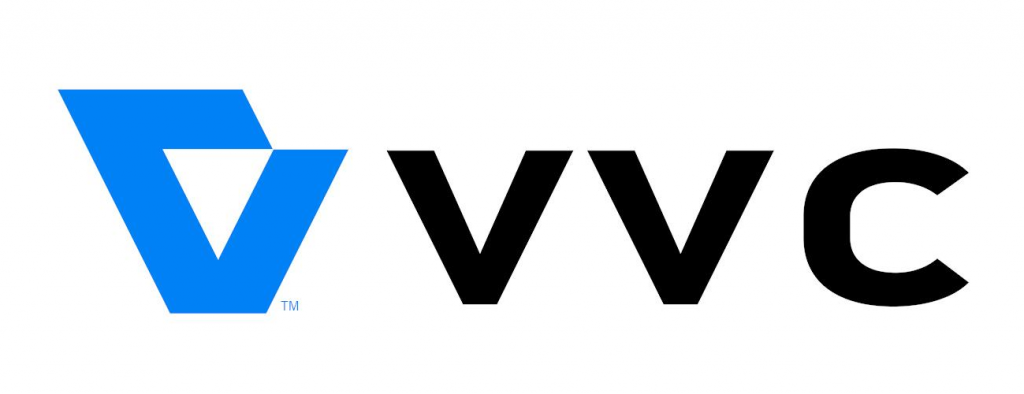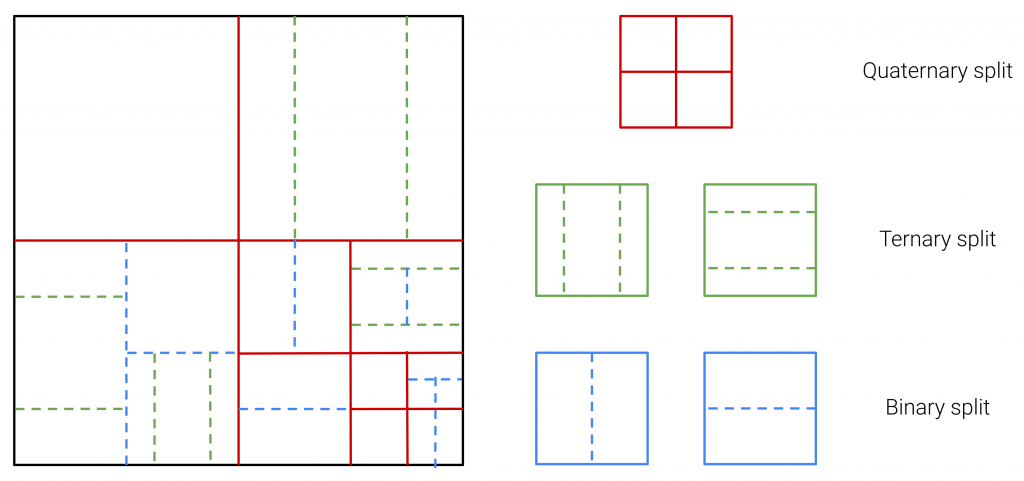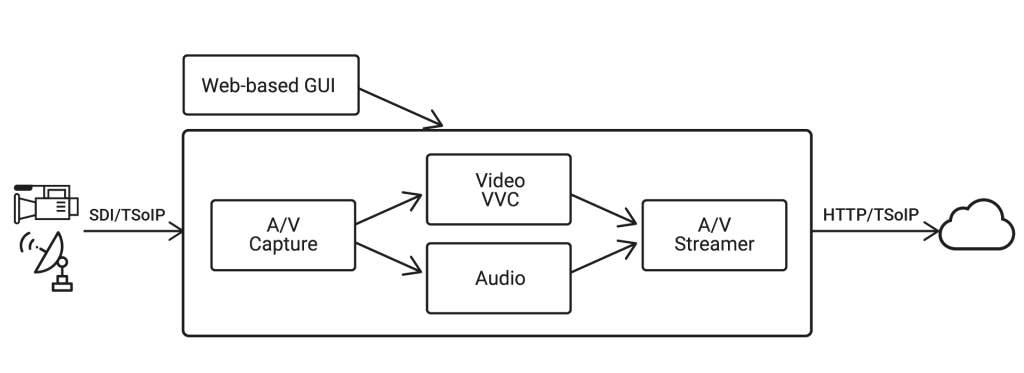Technology/
Versatile Video Coding: VVC
Designed to further reduce the bitrate beyond HEVC for applications such as 8K broadcasting and streaming. Learn more about Spin Digital’s unique implementation of VVC decoder and media player.
The VVC/H.266 Standard
The new-generation coding standard called Versatile Video Coding (VVC), also known as H.266, was completed in July 2020 by the Joint Video Experts Team (JVET) of ISO and ITU.
The new standard includes many more coding tools than its predecessor, H.265/HEVC, making it more efficient in terms of compression but, at the same time, more complex computationally. As result, VVC achieves up to 50% bitrate reduction over HEVC for the same visual quality.
VVC represents the state-of-the-art in video coding targeting 50% bitrate reduction with respect to HEVC for the same visual quality.

Some of the key coding tools supported in VVC include:
- Maximum Coding Tree Unit (CTU) size extended to 128×128 samples instead of the 64×64 samples of HEVC
- More flexible CTU partitioning with quaternary splits followed by ternary and binary splits (see figure below).
- 93 angular modes (almost three times as many modes than HEVC), planar, DC, Matrix-based prediction (MIP), and 8 new tools
- Enhanced motion vector prediction and merge modes, and 7 more intel modes than HEVC, including non-translational motion representation (e.g. rotation, scaling) and bidirectional optical flow, among others.
- Maximum DCT transform size extended to 64×64 samples (including non-squared transforms) instead of the 32×32 samples of HEVC, allowing for more energy compaction for the residue of large smooth areas
- Enhanced four-stage in-loop filtering: luma mapping with chroma scaling, deblocking filter, Sample Adaptive Offset (SAO), and Adaptive Loop Filter (ALF)
- Advanced Context-based Adaptive Binary Arithmetic Coding (CABAC) with multi-hypothesis probability estimate

In addition to bitrate savings over preceding coding standards, VVC is designed to provide efficient video coding for different video characteristics:
- 8K and beyond: Videos in very high resolution can be compressed more efficiently through more flexible block partitioning and larger block sizes (up to 128×128 samples)
- HDR video: VVC significantly improves the compression efficiency of HDR videos with enhancements in the deblocking filter and a new in-loop filter called luma mapping
- Professional color formats: Already in its first version, the standard includes support for professional color formats such as 4:2:2 and 4:4:4, and RGB
- Screen Content Coding (SCC): SCC content, common in screen sharing and game streaming applications, can benefit from special tools that have been enhanced or simplified with respect to those in the HEVC SCC extension
- 360-degree video: Since an omnidirectional image consists of a 2D projection from a 3D sphere, higher compression can be achieved by exploiting the redundancies between the left and right boundaries of the picture
Besides, the encoder offers practical functionalities for actual and next-generation applications:
- Multilayer coding: The coding framework for spatial and quality scalability and multiview coding have been simplified compared to previous standards and are included in the first version of the standard, as opposed to later extensions as in HEVC.
- Ultra low-latency streaming: In VVC, the decoding of a bitstream can start at any point from inter-coded frames using a feature known as periodic intra refresh, preventing the use of intra-coded frames that may result in high bitrate spikes
- Adaptive streaming: The standard allows changing the video resolution within a video stream and using reference pictures having a resolution different from that of the image to be decoded
- Partial decoding: Through the new feature called subpictures, different rectangular regions of the picture can be independently coded for viewport-dependent 360-degree video streaming or region of interest (ROI) applications
As in HEVC, the VVC standard also supports Wavefronts (or WPP) and tiles for parallel processing on multicore architectures, but with some optimization towards the simplification of high-level syntax.
VVC Coding Tools
The table below shows a comparison between VVC, HEVC, and H.264, from different perspectives: coding tools, features, extensions, and applications.
| AVC/H.264 | HEVC/H.265 | VVC/H.266 | ||
|---|---|---|---|---|
| Partitioning | Quadtree (QT) | Quadtree plus Multi-type Tree (QT+MTT) | ||
| Coding tools | Largest block size | 16x16 | 64x64 | 128x128 |
| Smallest prediction unit | 8x8, 4x4 | Inter 8x4, Inter 4x8, Intra 4x4 | 4x4 | |
| Transform unit sizes | 8x8, 4x4 | 32x32 down to 4x4 | 64x64 down to 4x4, non-squared transforms | |
| Intra prediction | 10 Intra modes | 33 angular modes, DC, planar | 93 angular modes, DC, planar, matrix-based (MIP), 8 new tools | |
| Inter prediction | Quarter pel MV precision, up to 16 reference frames | Quarter pel MV precision, 8-tap filter, advanced motion vector prediction (AMVP), up to 16 reference frames | 1/16 MV precision, 8-tap filter, improved AMVP and merge modes, 7 more Inter modes such as non-translational motion modelling (Affine) and bidirectional optical flow (BDOF) | |
| In-loop filters | Deblocking | Deblocking improved, SAO | Luma mapping, deblocking improved, SAO, ALF | |
| Entropy coding | CAVLC, CABAC | CABAC enhanced | CABAC enhanced | |
| Picture partitions and parallel processing | Slices, FMO, ASO | Slices, tiles, WPP | Slices, tiles, WPP, sub-pictures | |
| Scalability | In SVC Extension | In SHVC Extension | Temporal, spatial, and quality in version 1 | |
| Screen Content Coding (SCC) | n.a. | In SCC Extension | Transform skip residual coding (TSRC), block-based differential pulse-code modulation (BDPCM), intra block copy (IBC), adaptive color transform (ACT), palette mode | |
| 360-degree coding | n.a. | Limited support in extensions | 360-degree coding in version1 | |
| Professional color formats | In Range Extensions: 4:2:2, 4:4:4, up to 16-bit | In Range Extensions: 4:2:2, 4:4:4, up to 16-bit | 4:2:0, 4:2:2, 4:4:4, 10-bit in version 1 | |
| Multiview and 3D coding | Multiview Extension | Multiview and 3D Extensions | Multiview in version 1 | |
| Applications | HD TV, Blu-ray, Internet video | UHD TV, 4K Blu-ray, 8K live streaming, VR, immersive projections, game streaming, remote desktop, low latency videoconferencing | Next-generation applications: 8K HDR broadcasting, adaptive and ultra-low latency streaming, SCC streaming, VR and immersive media | |
Compression Efficiency of VVC
VVC compression efficiency has been analyzed objectively and subjectively and compared to HEVC and other video coding standards.
The table below shows comparative results of the reference implementations of VVC, AV1, and EVC, with respect to HEVC in terms of compression efficiency and encoding complexity. Efficiency is computed as the average bitrate reduction at the same quality (based on PSNR) of the different test encoders with respect to the HEVC reference encoder. In that study a 4K (UHD) broadcast scenario was assumed.
According to the results VVC achieves higher compression efficiency than all other coding standards including HEVC, AV1, and EVC. VVC also exhibits the highest computational complexity, with its reference encoder (called VTM) requiring 8 times more computation than the HEVC reference encoder (called HM). It should be noted that these experiments have been conducted using reference encoders which are developed to demonstrate the capabilities of the standard but are not optimized for real video coding applications.
| VVC | AV1 | EVC | HEVC | |
|---|---|---|---|---|
| Bitrate reduction at equal PSNR referred to HEVC | 39.6% | 19.5% | 27.3% | 0.0% |
| Encoding complexity | 8.3x | 3.1x | 2.9x | 1.0x |
Spin Digital VVC Live Encoder
Spin Digital has developed a VVC real-time software encoder for UHD (4K and 8K) live streaming and broadcasting. Its first version achieves, for 4K video, a 18.0% bitrate savings at equal quality compared to Spin Digital’s HEVC live encoder. In the case of 8K video, the bitrate reduction amounts to 25.8%.

The encoder has been extensively optimized for latest-generation CPU architectures to achieve the performance and compression levels required for 4K and 8K video, with optimizations including: advanced coding-tool decision algorithms, SIMD processing, memory optimizations, and a multi-level parallelization approach.
With all these optimizations together, the VVC encoder is able to process 4Kp60 and 8Kp30 HDR 10-bit videos in real-time using a single server with a state-of-the-art dual-socket CPU architecture.
More information about compression efficiency and performance of the VVC encoder is found in the whitepaper.
Live 4K and 8K VVC Demonstration
The VVC live encoder was shown in action at IBC 2022, held in Amsterdam on September 15-18, 2022. The demonstration consisted of a live encoding, streaming, and playback workflow for 4Kp60 and 8Kp60 10-bit HDR. Click here to watch the demo.
Spin Digital VVC Decoder and Media Player
Spin Digital has developed a real-time VVC software decoder, which has been integrated into a complete media player that supports the full 8K format including: ultra-high definition (7680×4320 pixels), High Dynamic Range (HDR10, HLG), Wide Color Gamut (BT.2020), and High Frame Rates (up to 120 frames per second).
The key components of the VVC media player are:
- Support the Main 10 and Multilayer Main 10 profiles
- A highly optimized CPU-based VVC decoder capable of processing 8K videos at 60 Hz and 120 Hz in real-time using latest generation CPUs.
- An advanced video render engine for 8K with HDMI 2.1 (GPU) and SDI output interfaces.
8K VVC Demonstration
Spin Digital and Fraunhofer HHI presented in June 2021 a video coding and playback demonstration of 8K HDR using the VVC standard. Find more information on this demonstration here.
Media Player for VVC Scalability
VVC supports scalability, a video coding technique based on multiple layers, where each layer represents a different resolution or quality of the same video. The VVC decoder and player can also process scalable streams in real-time, allowing users to select the desired layer for display.
The new VVC player has been demonstrated with scalable streams that contain Full HD (1920×1080 pixels), 4K (3840×2160 pixels), and 8K (7680×4320 pixels) spatial layers at 60 frames per second.
References
- Bross B., Chen J., Ohm J. R., Sullivan G. J., and Wang Y-K., Development in International Video Coding Standardization After AVC, With an Overview of Versatile Video Coding (VVC), Proceedings of the IEEE, pp. 1-31, 2021.
- D. Grois et al. Performance Comparison of Emerging EVC and VVC Video Coding Standards with HEVC and AV1. SMPTE Motion Imaging Journal. May 2021.
- T. Nguyen et al. Overview of the Screen Content Support in VVC: Applications, Coding Tools, and Performance. IEEE Transactions on Circuits and Systems for Video Technology, vol. 31, no. 10, pp. 3801-3817, Oct. 2021, doi: 10.1109/TCSVT.2021.3074312.